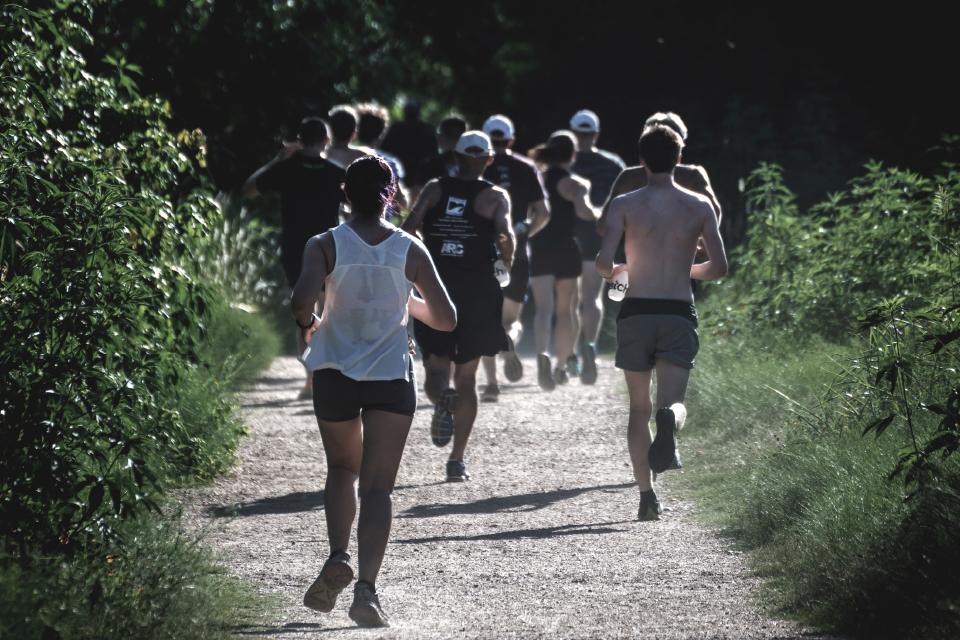Running to Race

Summers are hot, and most runners tend to find themselves struggling to even get out of the door. For some who train with Trail Roots, gearing training toward a race goal like the Capt’n Karl’s Trail Series helps them stay on a running schedule through the summer months.
The best part about the Capt’n Karl’s series is that the races start at 7 p.m., just before sunset, and last throughout the night. There are four races, each with a 10K, 30K, and 60K distance option (and even a free kids’ K), and the summer-long series offers many benefits: structure for those struggling with motivation in the summer, practice in night running for folks taking on ultra-marathon distances, and a break from the scorching heat for everyone.
Before signing up for the next night race, consider some of these tips:
Diet
Many runners are used to racing early in the morning, when they can get by with eating a banana, some toast, or a bowl of oatmeal before racing. If you try to eat light before a night race, you will be completely zapped of energy before the finish. Consume a fairly normal diet the day leading into the race. I tell my runners to eat their regular breakfast, a larger-than-normal lunch around 1 p.m., and follow with a nice snack around 4 p.m. (those with sensitive stomachs may want to avoid heavily acidic foods during lunch or for a snack). I typically eat my last snack or meal three hours before a race; this gives the food enough time to settle as well as provides the energy needed to complete the race.
Preparation
Familiarize yourself with the trail. If possible, visit the course once or twice before the race date (each of the four Capt’n Karl’s races, for example, is in a different location). This will help with a few potential problem areas. First, it will ensure that you know where to go and where to park, as well as what amenities the location has to offer (bathrooms, showers, camping, shade). Visit the park around a similar time to race start to practice running in the evening and managing food and hydration, both in preparation for and during the run. You can also test out running in the dark. Being alone on a trail at night can be scary for many runners. I admit that I can get scared running alone on the trail at night, too, so I tend to take my dog as company (or just run really fast). While the Capt’n Karl’s series doesn’t allow dogs on any of the race courses, spending more time out in the dark will help calm nerves and make running in the dark more comfortable on race night. Finally, it is a good practice to test out your equipment. You don’t necessarily want to show up to a night race with a brand new headlamp or flashlight. Be sure you know how to change batteries in your equipment and that wearing or holding your light source is comfortable.
Pacing
“Don’t go out too fast” or “Save your energy; it’s a long race” are two common pieces of advice for runners. These hold true for night races and especially for ultra distances, which are 50K (approximately 31 miles; a marathon is 42K, or 26.2 miles) or longer. In a 10K, it’s possible to go out hard and hang on for the final few miles. In a 60K, however, going out hard and blowing up at mile 15 puts a runner in a tough position, because there are still 22 miles remaining. Though it’s evening at race start, it is still hot, and as the sun goes down, it will cool off. As the light fades and the headlamps come on, terrain gets trickier. There is much working against achieving a negative split in a nighttime trail race, but successfully managing your energy will enable a strong finish and a happy body.
The final race in the Capt’n Karl’s is on Sept. 6 at Reveille Peak Ranch in Burnet, Texas. For background information on the Capt’n Karl’s series, read AFM’s article, “Trail Runners Take on the Dark Side with Capt’n Karl’s Race Series”






